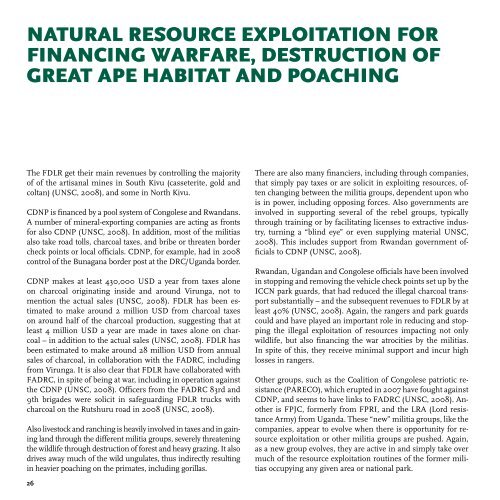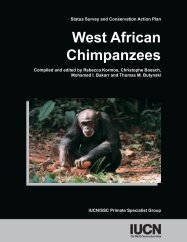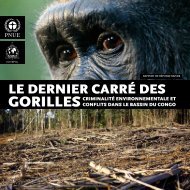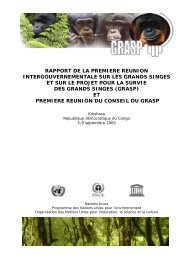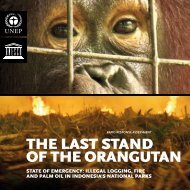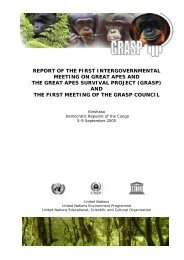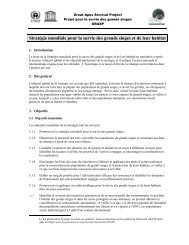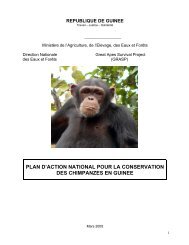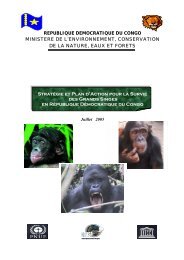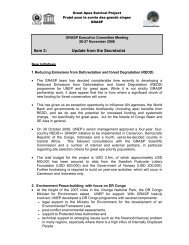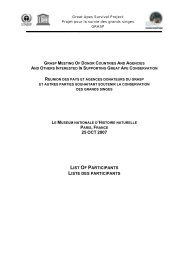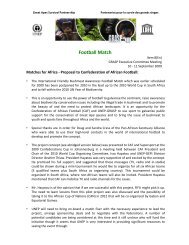THE LAST STAND OF THE - GRASP
THE LAST STAND OF THE - GRASP
THE LAST STAND OF THE - GRASP
Create successful ePaper yourself
Turn your PDF publications into a flip-book with our unique Google optimized e-Paper software.
NATURAL RESOURCE EXPLOITATION FOR<br />
FINANCING WARFARE, DESTRUCTION <strong>OF</strong><br />
GREAT APE HABITAT AND POACHING<br />
The FDLR get their main revenues by controlling the majority<br />
of of the artisanal mines in South Kivu (casseterite, gold and<br />
coltan) (UNSC, 2008), and some in North Kivu.<br />
CDNP is financed by a pool system of Congolese and Rwandans.<br />
A number of mineral-exporting companies are acting as fronts<br />
for also CDNP (UNSC, 2008). In addition, most of the militias<br />
also take road tolls, charcoal taxes, and bribe or threaten border<br />
check points or local officials. CDNP, for example, had in 2008<br />
control of the Bunagana border post at the DRC/Uganda border.<br />
CDNP makes at least 430,000 USD a year from taxes alone<br />
on charcoal originating inside and around Virunga, not to<br />
mention the actual sales (UNSC, 2008). FDLR has been estimated<br />
to make around 2 million USD from charcoal taxes<br />
on around half of the charcoal production, suggesting that at<br />
least 4 million USD a year are made in taxes alone on charcoal<br />
– in addition to the actual sales (UNSC, 2008). FDLR has<br />
been estimated to make around 28 million USD from annual<br />
sales of charcoal, in collaboration with the FADRC, including<br />
from Virunga. It is also clear that FDLR have collaborated with<br />
FADRC, in spite of being at war, including in operation against<br />
the CDNP (UNSC, 2008). Officers from the FADRC 83rd and<br />
9th brigades were solicit in safeguarding FDLR trucks with<br />
charcoal on the Rutshuru road in 2008 (UNSC, 2008).<br />
Also livestock and ranching is heavily involved in taxes and in gaining<br />
land through the different militia groups, severely threatening<br />
the wildlife through destruction of forest and heavy grazing. It also<br />
drives away much of the wild ungulates, thus indirectly resulting<br />
in heavier poaching on the primates, including gorillas.<br />
There are also many financiers, including through companies,<br />
that simply pay taxes or are solicit in exploiting resources, often<br />
changing between the militia groups, dependent upon who<br />
is in power, including opposing forces. Also governments are<br />
involved in supporting several of the rebel groups, typically<br />
through training or by facilitating licenses to extractive industry,<br />
turning a “blind eye” or even supplying material UNSC,<br />
2008). This includes support from Rwandan government officials<br />
to CDNP (UNSC, 2008).<br />
Rwandan, Ugandan and Congolese officials have been involved<br />
in stopping and removing the vehicle check points set up by the<br />
ICCN park guards, that had reduced the illegal charcoal transport<br />
substantially – and the subsequent revenues to FDLR by at<br />
least 40% (UNSC, 2008). Again, the rangers and park guards<br />
could and have played an important role in reducing and stopping<br />
the illegal exploitation of resources impacting not only<br />
wildlife, but also financing the war atrocities by the militias.<br />
In spite of this, they receive minimal support and incur high<br />
losses in rangers.<br />
Other groups, such as the Coalition of Congolese patriotic resistance<br />
(PARECO), which erupted in 2007 have fought against<br />
CDNP, and seems to have links to FADRC (UNSC, 2008). Another<br />
is FPJC, formerly from FPRI, and the LRA (Lord resistance<br />
Army) from Uganda. These “new” militia groups, like the<br />
companies, appear to evolve when there is opportunity for resource<br />
exploitation or other militia groups are pushed. Again,<br />
as a new group evolves, they are active in and simply take over<br />
much of the resource exploitation routines of the former militias<br />
occupying any given area or national park.<br />
26


